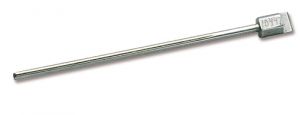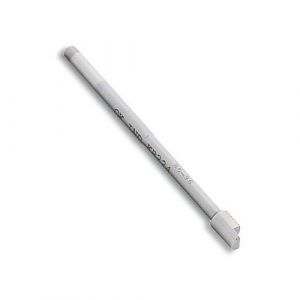Jonard / OK Industries P26LN Wire Wrap Sleeve 26 AWG, 3''
Solderless wire wrapping is a fast, reliable and inexpensive method of making connections to terminals in high-density electronic equipment. "Modified" wrapping bit is designed to wrap 1-1/2 turns of insulation around the terminal post. This is designed to provide extra strength to the connection and reduce wire breakage from vibration and pulling on wires. Each bit undergoes a series of tests for quality assurance. Groups of wire are wrapped on various types of test terminals and then subjected to strip tests to determine adequate tightness. Unwrap tests ensure against overtight wraps. The bit is compatible with any make or model wire wrapping tool.
How to Make Wire Wrapped Connections
- Insert the pre-stripped wire into the wire slot of the wrapping bit.
- Anchor the wire in the notch of the wrapping sleeve.
- Insert the terminal into the center hole of the wrapping bit.
- Activate the wire wrapping tool.
- This rotates the wrapping bit and wraps the wire around the terminal.
Helpful Wire Wrapping Tips
- Coiling the wires around the sharp corners of a .025 in. square receptacle post creates a wire wrapped termination.
- A clean metal-to-metal contact between the wire and the post can be achieved by bending the wire around the sharp corner,
- Breaking the oxide layer of both surfaces, thus revealing an oxide-free surface.
- Don't use wire that will break easily.
- The minimum number of turns is based on wire gauge and the type of wrap.
- Standard Wrap = Coils bare wire only around the post
- Modified Wrap = Coils the wire and a portion of insulation increasing the ability to withstand vibration.
- When using wire wrap guns, make sure to not hold too tightly against the board to prevent bunched up, messy coils around the base of the post.
- Holding a wrap gun with too little pressure can result in "Spiral Wraps" (spaces between the coils on the post, making the post visible).
- Pulling the trigger of the wrap gun too hard may result in broken wire inside the gun barrel.
- Backforce; feature on electric wrap guns important to prevent against overwrapping from excessive force.
- Proper Daisy Chain wiring several points together can be easy if done correctly, you would have at the most three wires to unwrap to remove any wire in the chain.
- This is the preferred approach.
Common Wire Wrapping Problems:
- The Overwrap -Don't press too hard! Wires will slip over the preceding turn if you push down too hard on the wrap tool while turning.
- Make sure to practice to ensure a quality connection.
- Insufficent Turns: Push wire all the way into wire slot. Improperly feeding of wire into the wire slot of the bit results in insufficient turns of wire for regular wraps or insufficient insulation turns for modified wraps.
- Spiral Wrap/ Open Wraps: Don't remove the tool too quickly! Wire turns more than 0.005 inches apart, called spiral or open wraps, are caused by too rapid a removal of the wrapping tool.
- Pigtails: Select the proper bit and sleeve. When a wire has not been completely wrapped the result may be a "pigtail". This results if the size of the bit is improperly matched to the terminal diagonal.
WARRANTY:
The OK Industries Division of Jonard Industries offers a limited warranty for these Wire Wrap Bits to be free of Manufacturing defects for One Year from date of purchase.








